8
Business Writing How To’s
Your supervisor asks you to develop a report or proposal or procedure. What now? Getting from that initial assignment to an effective final document can be daunting.
Breaking the task into simple steps can help. You plan, draft, revise, and edit your work. Specific strategies at each step can make the overall process quick and effective.
This chapter provides these steps to success, with practical strategies for getting started, getting words on the page, and making those words clear and correct.
In this chapter
Top 10 Tips for Business Writing
Before you start writing, consider your mindset.
Be committed. Care about your writing. It is a clear reflection of both you and your company.
Be conversational. Write as if you were speaking to your reader. Test your writing for effective tone by reading it out loud.
Be considerate. Know your readers and their needs in order to make recommendations or referrals.
Be connected. Understand your subject well by consulting customers, coworkers, and company records to gather information.
Be consistent. Make your point and stick to it. Keep your thoughts organized, and don’t wander off the subject.
Be clear. Think clearly and write using plain language, avoiding jargon and inflated rhetoric.
Be concrete. Always use specific names, numbers, and examples. (Eight is concrete; some is abstract.)
Be concise. Get to the point. You need not cover everything or try to include every detail.
Be complete. Tell the reader how to respond. Include all the names, dates, and numbers the reader might need.
Be correct. Check your facts for accuracy and your language for appropriateness. Always double-check names of people and companies for correct spelling.
Business Writing Steps to Success
It’s easy to feel overwhelmed about a writing project—especially if the form of writing is new to you, or the topic is complex. Just break the task into manageable steps: Plan, Draft, Revise, and Edit
This diagram shows the usual order of the steps to writing success, though you can move back and forth between them.
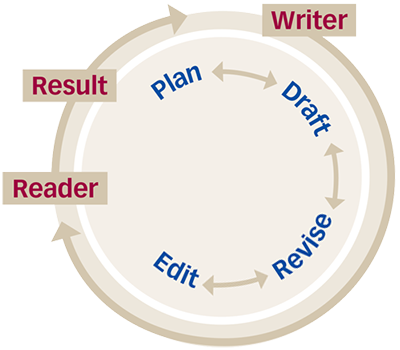
Plan
Goal: Find your focus and prepare to draft.
Activities: Clarify your purpose, think about your reader, choose a format, and list the information you need to share. Then do any necessary research, review models, and develop an outline.
Draft
Goal: Get your thoughts on the page.
Activities: Expand your outline with sentences and paragraphs that use a fitting tone.
Revise
Goal: Fix any content problems in the first draft.
Activities: Test the quality and clarity of the ideas, organization, and voice. Also check words and sentences. Add, cut, and clarify as needed.
Edit
Goal: Fine-tune the piece before sending it out.
Activities: Review format and design. Edit and proofread by checking grammar, punctuation, spelling, and mechanics.
Guidelines Plan
Your goal is to zero in on the message you want to send, think about the reader and context, and gather and organize information.
-
Clarify your message.
-
What is the subject of the message?
-
What specific result do you want to see from the message?
-
Is the desired goal or outcome realistic and measurable?
-
Do you need to inform or persuade to achieve results?
Informing tasks: state, clarify, outline, list, record, report, analyze, compare, describe, define, explain
Persuading tasks: request, sell, recommend, convince, apologize, evaluate, complain, turn down, promote
-
-
Profile your reader.
-
Is your reader within or outside your organization?
-
How well do you know your reader?
-
How much does your reader know about the topic?
-
What are your reader’s values, needs, and priorities? Is your message likely to be received positively or negatively?
-
Will your reader be making a decision or doing something? What authority and responsibility does your reader have?
-
Will there be a number of readers? If so, are they diverse in age, occupation, gender, education, culture, and language skills?
-
-
Know the context.
-
What type of document are you writing? What are its design requirements? How will you create, send, and store this document?
-
When must the document be finished and sent?
-
What information do you have available? What additional information do you need to gather?
-
What future contact or action might be needed by you, the reader, others?
-
“Good planning helps to make elusive dreams come true.”
—Lester R. Bittel
Using a Planner
Consider using a planner similar to the one below to help you clarify your message, reader, and context. Planners can be especially helpful for longer projects such as reports or proposals.
Planner
-
What is the subject?
-
Why am I writing?
-
Who is the reader?
-
What do I want the reader to think or do?
-
What are the reader's needs, biases, questions?
-
How can I get the desired results?
-
What information do I need?
-
Where can I find this information?
-
What form of writing should I use?
-
When and where do I need to send or submit this?
A planner similar to the one shown here can help you better understand the writing situation by focusing your attention on the 5W’s and H: who, what, when, where, why, and how.
Freewriting
Writing whatever comes to mind on a particular topic is called freewriting. Freewriting is really brainstorming on the page. It helps you record, develop, and understand your thinking.
Write nonstop about your subject or project, following rather than directing your thoughts.
Resist the temptation to stop and judge or edit what you write.
If you get stuck, switch directions and follow a different line of thinking.
When you finish, reread your material and highlight passages you think might be useful.
Clustering
Clustering creates a web of connections between a general topic and specific subtopics. A cluster allows you to see the structure of your topic and plan your writing.
Write a key word or phrase in the middle of your page.
Record or “cluster” related words and phrases around this key word.
Circle each idea and link it to related ideas in your cluster.
Continue recording related ideas until you have covered the topic.
Sample Cluster
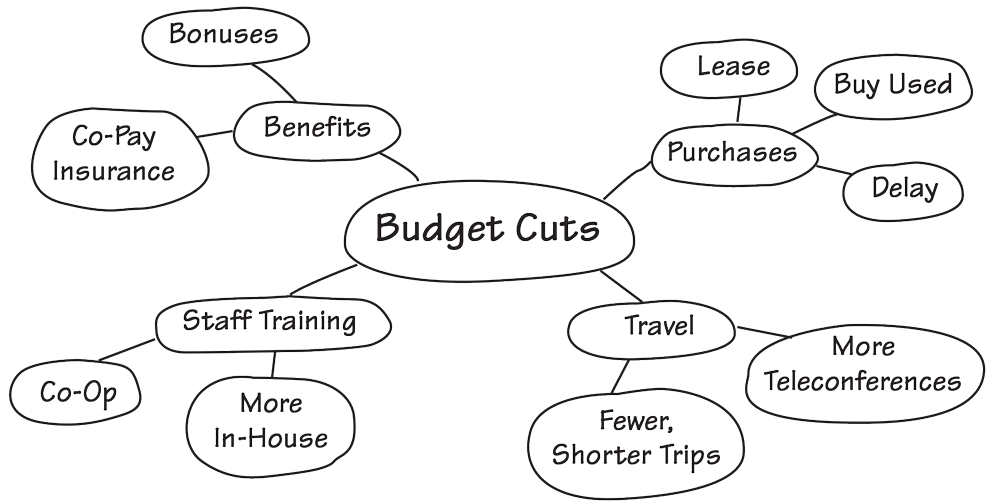
Diagramming
Diagrams can be used to help you record and organize information graphically. The diagrams below are two of the most useful.
Use a Venn diagram to compare and contrast two things.
Use a problem/solution diagram to analyze a problem, break it into parts, specify its causes, list its effects, and develop solutions.
Venn Diagram
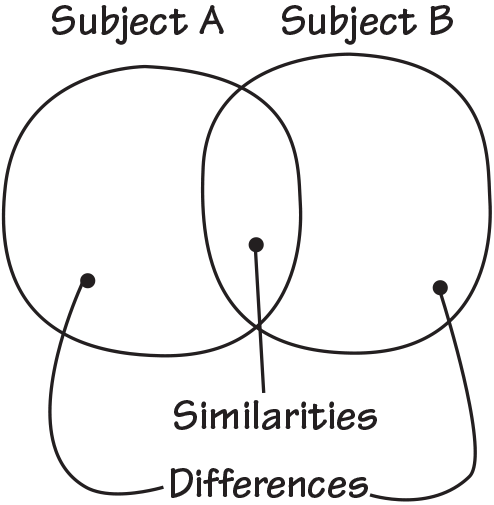
Problem/Solution Diagram
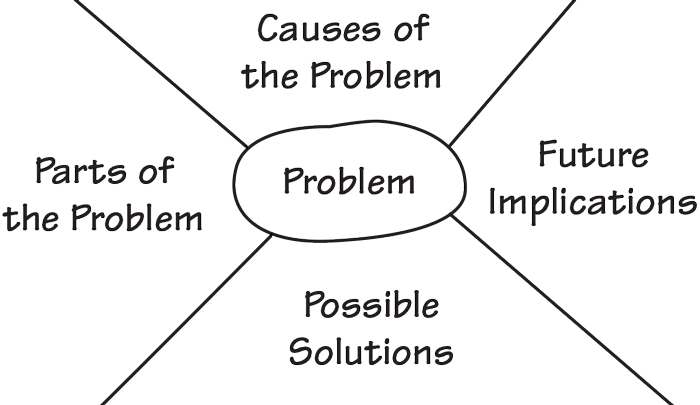
Outlining
One way to organize the information you’ve collected is to construct an outline or a detailed list. Follow the guidelines below to get started.
Find your focus. Clarify the main point or controlling idea of your writing project.
Develop your outline. A good outline provides a plan for developing your main point:
Highlight the key ideas you’ll want to use to develop your main point.
Connect your supporting details to these key ideas. Add ideas and details as needed, and number them appropriately.
Arrange your information into the best possible order. Consider your reader’s likely response, and select a sequence that best advances your main point. You may use your own method of development or one of these approaches:
cause/effect
question/answer
chronological order
classification
compare/contrast
order of importance
partitioning
problem/solution
Outline
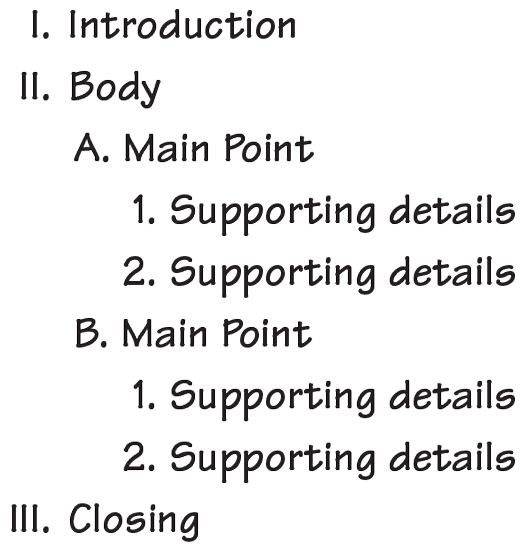
Guidelines Draft
Your goal when drafting is to get your ideas on the page, using your planning to guide you.
-
Gather your materials.
-
Make your writing area efficient and comfortable.
-
Set aside a block of uninterrupted time if possible.
-
Place your writing tools and planning materials within easy reach.
-
-
Use your planning materials.
-
Draw on your planning, clustering, freewriting, or outlining.
-
Review other documents related to your message.
-
Highlight statements, facts, examples, and graphics to include in your draft.
-
-
Focus on ideas, organization, and voice.
-
Develop a logical flow.
-
Common approaches include moving from overview to close-up, background to discussion, problem to solution, main idea to explanation, or familiar topic to new information.
-
-
Use paragraphs to group similar thoughts together.
-
Present the topic in a single sentence, and then support that topic in a single paragraph.
-
Consider possible closings or conclusions. Doing so can help focus and direct your drafting.
-
“Why do writers write? Because it isn’t there.”
—Thomas Berger
Drafting Openings
Your opening should quickly set a clear direction for your writing. Use the guidelines and models below to help you do that.
An effective opening should . . .
indicate the document type (report, proposal, instructions);
state your topic, your reason for writing, and your main point (if appropriate);
get the reader’s attention and interest;
establish a tone or voice;
provide background and context;
preview the content; and
provide a summary (if appropriate).
In many documents, the subject line opens your message. Write subject lines that clearly and succinctly state your subject.
Simple Opening (letter)
contextThank you for requesting a credit account at Cottonwood Hills Greenhouse and Florist Supply. main pointWe are pleased to extend you $100,000 in credit based on Dale’s Garden Center’s strong financial condition. positive toneCongratulations!
Complex Opening (report, proposal)
subject lineSubject: Report on Investigation of Cockroach Infestation at 5690 Cherryhill
backgroundDuring the month of July, 26 tenants from the 400-unit building at 5690 Cherryhill informed the building superintendent that they had found cockroaches in their units. On August 8, the Management-Tenant Committee authorized our group to investigate these questions:
-
objective toneHow extensive is the cockroach infestation?
-
How can the cockroach population best be controlled?
preview of contentWe investigated this problem from August 9 to September 10. This report contains (1) a summary, (2) an overview of our research methods and findings, (3) conclusions, and (4) recommendations.
Drafting the Middle
In the middle part of your message, you need to develop strong, clear paragraphs that advance the main idea presented in your subject line and introduction. Follow your outline and tackle one paragraph at a time. If necessary, go back to your planning materials or rework your outline.
An effective middle should . . .
link back to the opening through a clear transition,
provide readers with necessary information, and
include well-written paragraphs that have strong opening sentences.
To achieve the goals above, follow these guidelines:
Develop each main point in a separate paragraph.
Keep each paragraph fairly short, 3 to 8 lines in length.
Use a topic sentence to signal each paragraph’s direction.
Expand and connect ideas, always keeping your reader in mind.
Incorporate headings, lists, and graphics when appropriate.
Maintain the tone established in the opening.
Prepare readers for the closing.
Sample Middle Paragraphs (Letter)
clear topic sentencesAs you requested, I have enclosed a list of Home Builders’ affiliates in Missouri. Each affiliate schedules and handles its own work groups. Call or write directly to any of them for more information about local offerings.
helpful tone throughoutBecause you are in college, I have also enclosed some information on Home Builders’ Campus Chapters. The pamphlet explains how to join or start a Campus Chapter and discusses service learning for academic credit.
prepare reader for closingFeel free to contact Ben Abramson, the Campus Outreach Coordinator for your area, at the address on the enclosed material.
“The art of writing is the art of applying the seat of the pants to the seat of the chair.”
—Mary Heaton Vorse
Drafting Closings
Close your writing logically and naturally by recalling your goal and main point. Your closing should help the reader understand and act on the message.
An effective closing should . . .
restate your main point and offer conclusions;
provide recommendations, propose the next step, or offer help;
focus on appreciation, cooperation, and future contact;
include all details needed for follow-up and action; and
end with energy by using clear, strong verbs.
Note: Avoid stating the obvious in your closing, or rambling on and on.
If appropriate, present possible outcomes or long-term implications of what has been discussed. In other words, what’s the real bottom line?
Simple Closing (memo, email, letter)
focus on cooperationWith short-term solutions and long-term cooperation, together we will keep Premium Meats operating and prospering.
recommendation and follow-upIf you have any questions or suggestions, please speak to your immediate supervisor or a member of the Quality Task Force. (Task Force information is supplied in the attachment.)
Complex Closing (report, proposal)
restatement of main point Our proposal is to replace our internal-combustion forklifts with electric lifts. This change will involve a higher initial cost but will reap two important benefits: (1) CO levels will drop below OSHA’s recommended 25 ppm, ensuring employee safety and product quality; (2) in the long run, the electric lifts will prove less costly to own and operate. focus on outcomes
recommendation Therefore, I recommend that Rankin management approve this plan, to be phased in over the next four years as outlined above. action, future contact Improved safety and product quality, combined with total operating costs over the long run, outweigh the plan’s initial costs. If you wish to discuss this proposal, please call me at extension 1449.
Guidelines Revise
Your goal when revising is to make major improvements to ideas, organization, voice, words, and sentences.
-
Set aside the draft.
-
Let your draft sit for a few minutes if it’s a simple email.
-
Let your draft sit for a day or two if it’s a major report.
-
-
Create a revision copy of the file.
-
Give your revision file a new name so that you can cut, add, rearrange, and rewrite without fear of losing your original work.
-
-
Review your purpose.
-
Check to see that your message stays focused.
-
Make sure you address your reader’s potential questions: Why did I receive this? What’s the point? Why is it important?
-
-
Read the draft aloud.
-
Identify problems in content and tone.
-
-
Check ideas, organization, and voice.
-
Add comments about the focus, details, and overall flow of your draft.
-
Use the “Track Changes” feature of your word-processing program. Use the least-obtrusive view when reading the document. Then switch to show all changes to see how your thinking has evolved.
-
Before you accept and reject changes, save the document using a new file name. That way you keep a record of what you have done and can revert to previous wording if needed.
-
-
-
Use precise nouns, active verbs, and modifiers that clarify.
-
Vary sentence beginnings, functions, and structures.
-
-
Get input from others.
-
Get a fresh view of your writing from an objective perspective.
-
“Saint, noun. A dead sinner revised and edited.”
—Ambrose Bierce
Revising Your Writing
Revise Ideas
If your first draft lacks focus, substance, or clarity, you need to revise your ideas.
Problem:
The message is unfocused.
Listen for
“This just rambles.”
Look for
Thursdays are generally light days for truck undercoating. However, during a routine inspection, I found an undercoater struggling to breathe under a truck. It was the same day that we got the oil filters.
Solution:
Check the focus of the document and each paragraph.
Cut material that does not support the main point. Make sure the main point clearly states the subject and purpose of the message. Check that the details in each paragraph support the topic sentence.
Revised Version:
During a routine inspection of work on Thursday, March 21, at 10:45 a.m., I found undercoater Bob Irving struggling to breathe underneath the truck he was working on.
Problem:
The message isn’t very informative.
Listen for
“It’s not very specific.”
Look for
Maintainer Corporation provides suits to protect undercoaters from this.
Solution:
Expand explanations and offer examples.
Answer the reader’s main questions about the subject—who? what? where? when? why? and how? Provide concrete examples if needed.
Revised Version:
Maintainer Corporation provides oxygen suits to protect undercoaters’ skin and oxygen supply from sealants that (a) produce noxious fumes, (b) cause choking if swallowed, and (c) injure skin upon contact.
Problem:
The message is unclear.
Listen for
“I don’t get it.”
Look for
We should do something about the problem. The facts point toward an investment in new equipment and in undercoaters working together.
Solution:
Rework your main point and rewrite confusing parts.
Express your main point clearly and specifically. Define any terms that may be unclear. Tell the reader specifically what outcome you seek.
Revised Version:
To further protect undercoaters from sealant hazards, I recommend the following actions:
-
Purchase oxygen suits and equipment that meet the OSHA oxygen-safety standards. In particular, air-hose locks should have emergency-release latches.
-
Raise trucks on a lift so that undercoaters may stand.
Revise Organization
If your draft has a weak opening, middle, or closing, revise for organization.
Problem:
The opening is weak.
Listen for
“I didn’t finish reading.”
“What is this about?”
Look for
As you know, insurance is important when accidents happen. How are you doing with coverage?
Solution:
Check your main point and background.
Make sure your main point clearly names your subject and your purpose for writing. Provide any background needed to understand the main point. Also, get the reader's attention by focusing on the person's needs.
Revised Version:
Periodically, insurance companies review the cost of offering their policies and then make changes where needed. When changes are made, it’s my responsibility as an agent to inform my clients and help them make necessary adjustments.
Problem:
The middle is disorganized.
Listen for
“It’s all a jumble.”
Look for
Hawkeye Casualty has chosen not to renew you. In order to keep their premiums low, some insurance companies will not cover high-risk drivers. In the past two years, you have had an at-fault accident and four moving violations. Your present coverage will cease January 31. A nonstandard company is willing to insure you.
Solution:
Check your supporting points and order.
Make sure each paragraph has a topic sentence that supports the main point and that summarizes the point of the paragraph. Place these supporting points in the best order.
Revised Version:
Last week Hawkeye Casualty, your auto insurance carrier, discontinued all policies for “high-risk” drivers. Your at-fault accident and four moving violations put you in that category. As a result, Hawkeye Casualty has cancelled your auto insurance policy effective January 31. However, I have found another company that will cover you. While the cost of the new policy is somewhat higher than your present policy, the coverage is comparable, and the company is reliable.
Problem:
The closing is weak.
Listen for
“It just ends.”
Look for
This coverage issue needs attention soon.
Solution:
Restate the main point and give next steps.
Summarize the document and tell the reader specifically what should happen as a follow-up. Provide a call to action (a command statement) if appropriate.
Revised Version:
Please call me at 555-0020 before the end of the month so that we can discuss the situation and decide how to proceed.
Revise Voice
If the voice does not fit the writing situation, you’ll need to revise it.
Problem:
The voice sounds arrogant.
Listen for
“It’s off-putting.”
Look for
We at Birks Cleaners provide the best dry cleaning around. We’re in our third generation. Our quality speaks for itself.
Solution:
Focus on the message and receiver, not on yourself.
Create a “you attitude” by addressing the receiver’s needs and interests.
Revised Version:
At Birks Cleaners, you’ll find services to meet all your dry cleaning needs. For three generations, our goal has been to treat your clothes as if they were our own.
Problem:
The voice gets in the way of the message.
Listen for
“It’s too flowery.”
Look for
From the starting pistol of this pivotal project, Janice worked with super-human strength to maneuver the company ship through the turbulent waters of this transition.
Solution:
Make the voice transparent.
Focus on the message instead of the words. Rewrite passages that say, “Look at these words.”
Revised Version:
From start to finish, Janice worked hard to help us manage during this often difficult transition.
Problem:
The voice is inappropriate.
Listen for
“Don’t be flip.”
Look for
Even though your being inconvenienced wasn’t entirely our fault, we’re obviously sorry about it.
Solution:
Use the right formality for the situation.
Match the seriousness of tone to the message, medium, receiver, and context.
Revised Version:
We apologize that your confirmed room was unavailable last night, and we are sorry for the inconvenience this may have caused you.
Revise Words
If the message is wordy, unclear, or negative, you’ll need to revise the word choice.
Problem:
The message is wordy.
Listen for
“Get to the point.”
Look for
The committee has been organized and set up in order to provide leadership in our effort to improve our abilities to communicate in and between departmental structures.
Solution:
Cut repetition and vague phrases.
Make your point in as few words as necessary. Replace wordy phrases with concise, specific nouns and verbs.
Revised Version:
The committee’s goal is to improve communication between all departments.
Problem:
The words are unclear.
Listen for
“It’s cliched.”
“What is this jargon?”
Look for
Pursuant to his request, I analyzed Bob’s physiological constitution and determined that his physical state of being was unimpaired.
Solution:
Use clear, direct words.
Cut jargon and cliches. Use clear, simple, specific words to get your point across.
Revised Version:
I checked Bob for injuries and determined that he was unharmed.
Problem:
The message is negative.
Listen for
“You sound angry.”
Look for
I read your memo requesting that all sales reps be given a whole day off for training in Cincinnati. While that stuff is important, Oscar, the bottom line is no less important! So I have no choice but to say, “No.”
Solution:
Use neutral or positive words.
Focus on the positive instead of the negative. Avoid insensitive or derogatory phrasing.
Revised Version:
I reviewed your request to send all the sales reps to the training seminar in Cincinnati. I agree that this training would help your staff be more productive. However, our budget for . . .
Revise Sentences
If the sentences in the message sound choppy, tired, or rambling, revise them.
Problem:
The sentences sound choppy.
Listen for
“Smooth this out.”
Look for
I am responding to your job advertisement. It appeared in the Seattle Times. The date was June 12. It’s the Software-Trainer job.
Solution:
Combine sentences and add transitions.
Connect related sentences using a comma and a coordinating conjunction or a subordinating conjunction. Add transition words and phrases to smooth the flow of thought.
Revised Version:
In response to your advertisement in the Seattle Times on June 12, I am applying for the position of Software-Training Specialist.
Problem:
The sentences sound tired.
Listen for
“This sounds sluggish.”
Look for
Your getting back to me in a short time was greatly appreciated. Some people take a lot longer. Some of your other people may also want to meet me next Thursday.
Solution:
Use active voice, and change negative to positive.
Find what is performing the action of the verb and make it the subject of the sentence. If a sentence states a negative (what is not going to happen), rewrite it to state a positive (what is going to happen).
Revised Version:
Thank you for your quick response to my letter of application for the position of Software-Training Specialist. I look forward to meeting you and the staff at Evergreen Medical Center next Thursday.
Problem:
The sentences ramble.
Listen for
“I got lost.”
Look for
I enjoyed touring your facilities and meeting your office managers, and I would enjoy contributing to the work that you and other staff members do at Evergreen, and I believe that my hospital training would be an asset.
Solution:
Divide rambling sentences into shorter units.
Separate ideas into smaller groups, perhaps made up of one, two, or three ideas (not more).
Revised Version:
After touring your facilities and meeting your office managers, I am certain that I would enjoy working at Evergreen Medical Center. I believe that my hospital training would be an asset.
Guidelines Edit
Your goal when editing is to check grammar, usage, and mechanics; check the format; and create an effective final design.
-
Make sure you’ve finished revising for overall meaning.
-
If possible, let the draft sit for a while.
-
Get mentally prepared to check your draft word by word.
-
-
Gather your tools.
-
Use your “Proofreader’s Guide” for punctuation, mechanics, usage, grammar, and sentences.
-
Keep a dictionary, thesaurus, and company style sheet handy.
-
Utilize computer tools (spell check, online thesaurus, grammar check, templates, cut-and-paste, find-and-replace).
-
-
Decide how much time you have to edit.
-
Consider the overall importance of the document.
-
The wider the distribution, the higher the reader’s status, or the more complex the content—the more carefully you should edit.
-
-
Follow logical steps.
-
First, check for the most common errors.
-
Next, check the document’s format and design for correctness, readability, and consistency with similar documents.
-
Finally, address details related to distributing the document.
-
-
Find an objective reader.
-
Turn to a coworker with good editing skills.
-
Share documents with managers, experts, and legal counsel as needed.
-
-
Use your computer wisely.
-
Run a final grammar check and spell check to catch basic errors.
-
Print out your document and proofread it carefully.
-
“A synonym is a word you use when you can’t spell the word you first thought of.”
—Burt Bacharach
Edit for Correctness
In addition to spelling errors and typos, the issues listed below commonly plague business documents. When editing your writing, use this list to find and correct the problems. See the chapter on correctness and consult your “Proofreader’s Guide.”
- Fix Pronoun-Antecedent Agreement
To help
eachnew employees learn our day-to-day procedures, please lead them through the orientation program. - Eliminate Shifts in Person
When new employees go through this orientation,
youthey learnyourtheir jobs more quickly. - Fix Subject-Verb Agreement
The procedure, as well as the attached checklist of steps and items,
covercovers key orientation topics. - Connect Dangling Modifiers
After filling in the review form for the new employee,
the form should be sentyou should send the form to the Human Resources Department. - Make Construction Parallel
The form describes issues at each stage of the evaluation process: after one day, one week
later,thentwo weeksafter starting, andwhenone month. - Fix Sentence Fragments
The form will streamline orientation for new employees. They will require m
Much less time to learn their new assignments. - Fix Comma Splices
The new checklist contains more information than the old one, so the new one will take longer to complete.
- Use a Comma After an Introductory Phrase or Clause
After the final review, the supervisor and the employee will sign the form.
- Use a Comma in a Compound Sentence
Reviewers should use the form for 30 days, and the manager should sign off on it.
- Use Commas Around Nonrestrictive Information
For each new employee, Human Resources, which must complete the initial evaluation, will prepare a checklist with the employee's name on it.
Checklist Business Writing Steps
Your goal is to develop important messages by using the steps to success—plan, draft, revise, and edit.
-
-
Ideas: Have I analyzed my purpose and audience, developed a measurable goal, and collected information?
-
Organization: Have I organized my thoughts by using graphic organizers and/or outlining?
-
-
-
Ideas: Have I recorded all my key points and essential information?
-
Organization: Have I created an opening, a middle, and a closing?
-
Voice: Have I maintained a person-to-person tone from start to finish?
-
-
-
Ideas: Have I fixed problems with the draft’s overall focus, clarity, and content? If appropriate, have I gotten feedback from a colleague?
-
Organization: Have I sharpened the opening to pull readers in, reworked the middle paragraphs to improve flow and coherence, and improved the closing to help readers take the next step?
-
Voice: Have I fixed any lapses in attitude, level, or energy so that the topic and reader are in the foreground and I am in the background?
-
Words: Have I eliminated cliches, jargon, and redundancy so that the wording is concise, clear, and positive?
-
Sentences: Have I removed choppy, tired, and rambling sentences by using parallelism, transitions, active voice, and variety?
-
-
-
Correctness: Have I proofread for sentence, punctuation, mechanics, spelling, and usage errors (using but not relying solely on a grammar check and a spell check)? If appropriate, have I gotten editing help?
-
Design: Have I fine-tuned the format, page layout, and typography to make the document professional, inviting, and readable?
-
“A process cannot be understood by stopping it. Understanding must move with the flow of the process, must join it and flow with it.”
—Frank Herbert